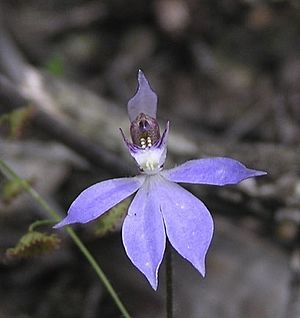Western tiny blue china orchid facts for kids
Quick facts for kids Western tiny blue china orchid |
|
|---|---|
 |
|
| Caladenia aperta growing near Ravensthorpe | |
| Scientific classification | |
| Genus: |
Caladenia
|
| Species: |
aperta
|
| Synonyms | |
|
|
The Caladenia aperta, often called the western tiny blue china orchid, is a lovely plant from the orchid family. You can only find this special flower in Western Australia, which means it is endemic to that area. It has a fairly narrow leaf and usually grows just one bluish-mauve flower. This orchid is different from other similar blue orchids because the sides of its labellum (a special lip-like petal) stand up straight but are not close to the column (the central part of the flower). It also grows further east than two other similar orchids, C. amplexans and C. sericea.
What Does This Orchid Look Like?
The Caladenia aperta is a perennial plant, meaning it lives for more than two years. It grows on the ground (it's a terrestrial plant) and loses its leaves each year (it's deciduous). This herb has an underground tuber (a swollen part of the stem) and one hairy leaf. The leaf is about 30 to 50 mm (1.2–2.0 in) long and 4 mm (0.16 in) wide.
Usually, only one bluish-mauve flower grows on a stalk that is about 50 to 150 mm (2.0–5.9 in) tall. The flower itself is about 20 mm (0.79 in) long and wide. Sometimes, the flower can be white, or the blue flowers might be a lighter color on the outside.
The top petal, called the dorsal sepal, stands up straight. It is about 11 to 16 mm (0.43–0.63 in) long and 2 to 3 mm (0.079–0.118 in) wide. The side petals and sepals are similar in size to the dorsal sepal, though the side sepals are a bit wider.
The labellum is the special lip-like petal, and it is about 6 to 9 mm (0.24–0.35 in) long and wide. It is reddish-mauve with darker stripes. The sides of the labellum curve upwards but do not wrap around the column (the central part of the flower). The tip of the labellum points downwards and is white and yellow. There are also two rows of yellow, stalked bumps called calli along the middle of the labellum. This orchid flowers from August to early October.
How Did It Get Its Name?
The western tiny blue china orchid was first officially described in the year 2000. Two scientists, Stephen Hopper and Andrew Brown, gave it the name Cyanicula aperta. They published their description in a scientific journal called Australian Systematic Botany, based on a plant they found near Jerramup.
Later, in 2015, another scientist named Mark Clements changed its name to Caladenia aperta. He did this after studying the plant's molecular phylogenetics, which looks at how plants are related using their DNA. The second part of its scientific name, aperta, comes from a Latin word that means "open." This refers to the space between the upright sides of the labellum and the column.
Even though its common name suggests it's tiny, the flowers of this orchid are actually about the same size as those of the dainty blue china orchid, Caladenia amplexans.
Where Does It Grow?
You can find the western tiny blue china orchid along the south coast of Western Australia. It grows in areas from the Cape Arid National Park all the way to Dumbleyung. These areas include different natural regions like the Avon Wheatbelt, Coolgardie, Esperance Plains, and Mallee biogeographic regions. It likes to grow in heathlands (areas with small shrubs), in shrublands, or on granite rocks.
Is It Safe?
The Western Australian Government's Department of Parks and Wildlife has classified Caladenia aperta as "not threatened." This means that, for now, there are enough of these orchids, and they are not considered to be in danger.

